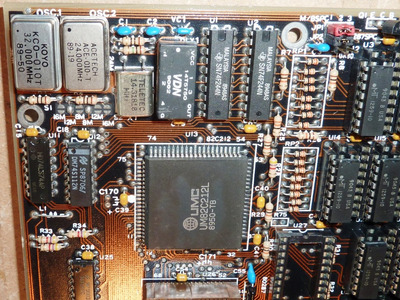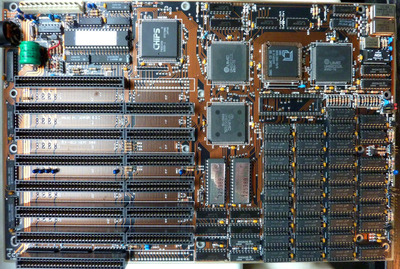First post, by majestyk
- Rank
- Oldbie
When you think of a speed issue you probably have CPU speeds in mind that are too slow.
Here´s the opposite case: I required a nice 286 mainboard in very good condition at a reasonable price last week. The AMI-BIOS ID-string is "1165" - that´s supposed to be "Mercury Computer Corporation". Maybe it´s this company:
https://en.wikipedia.org/wiki/Mercury_Systems
The chipset is "UMC 82C211L, UMC 82C212L, UMC 82C215L and Chips and Technology 82C206". I think this could be manufactured completely by C+T.
The name of the board seems to be "Bi-032 NEAT 286".
I cleaned the whole board carefully (as I always do), checked for visible defects like loose pins at the chips, damaged traces etc., replaced the battery with a new Varta NiMH type and was reedy to do some basic tests.
The board came with a AMD "N80L286-12/S" cpu. After reconfiguring the BIOS settings I was surprised to find out the CPU was running at 16 MHz!
On the board there are two 3-pin jumpers to adjust the speeds of CPU and FPU plus there´s a connetor for the turbo-switch. Accordingly there´s one oscillator for 24 MHz and one for 32 MHz. The 3-pin jumpers connect CPU / FPU with the desired oscillator. At each oscillator there are also 3 soldering pads for 8, 12 and 16 MHz. The soldering pads control the circuits that do the frequency division. These were soldered for 12 MHz at Osc1 and for 8 MHz at Osc2. You could see the soldering was original, nobody had changed anything.
No matter how set the jumpers, the CPU would always run at 16 MHz or 8 MHz, NEVER at 12 MHz.
First I believed I had made some mistake with the jumpering but I soon found out the two oscillators had been interchanged. The sikscreen said 32MHz where the 24 MHZ oscillator was sitting and vice versa. I checked the solderings - everything was still in the original state, this was done in the factory!
Well, I have seen many cases where the silkscreen was wrong, but here it was correct. After swapping the oscillators all the speeds were correct.
I also had loads of keybord errors at 8 MHz speed before, that are now gone.
So the 12 MHz CPU has been running @ 16 MHz all those years 😀


